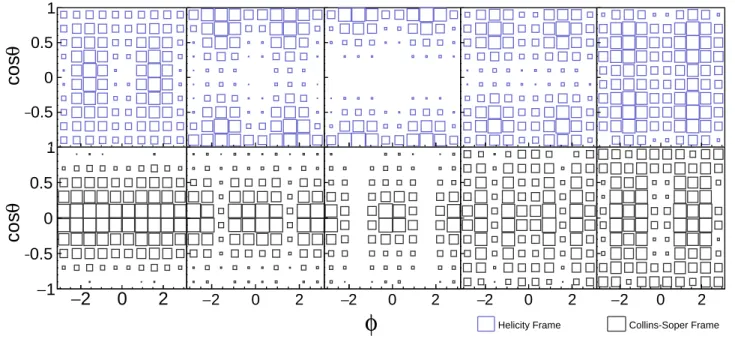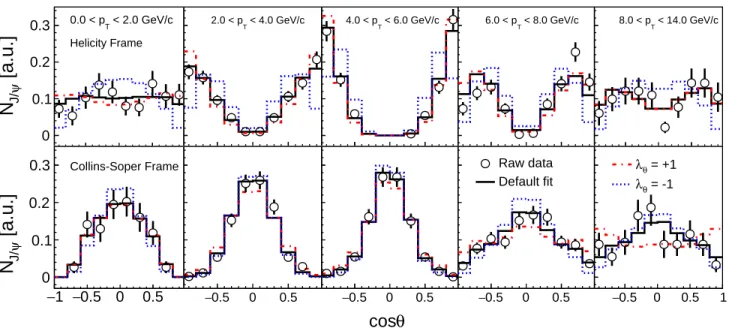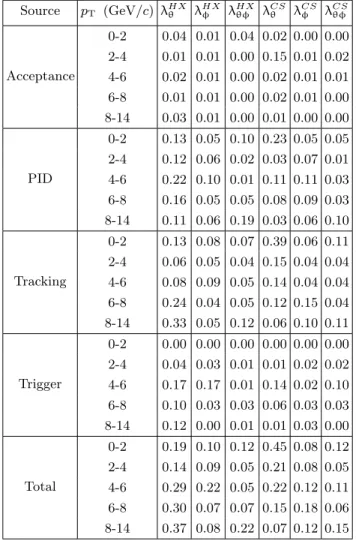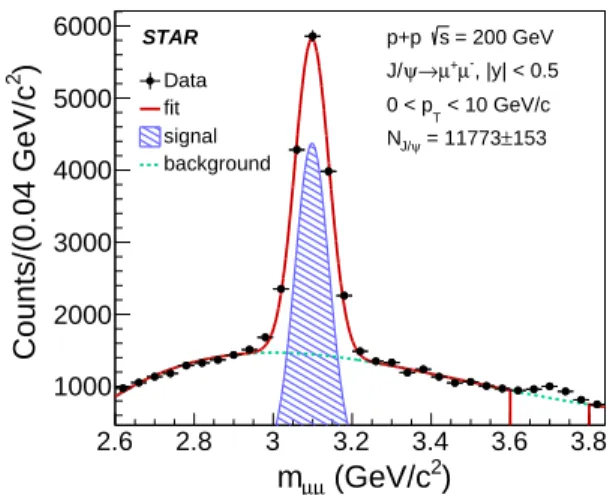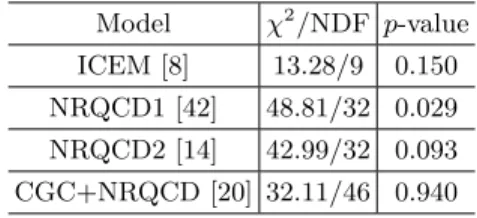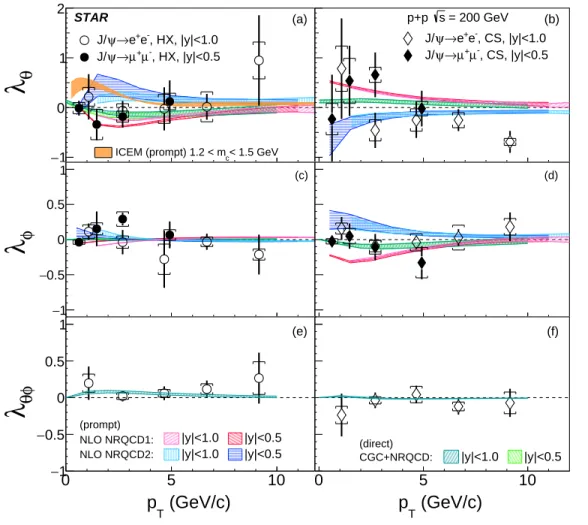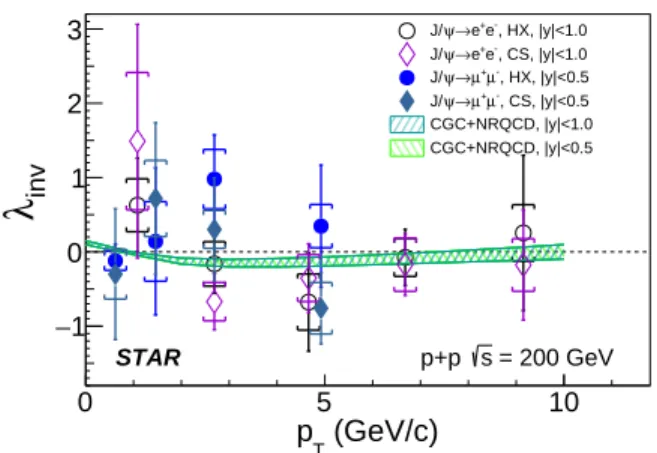Measurement of inclusive J/ψ polarization in p+p collisions at s= 200 GeV by the STAR experiment
J. Adam,6 L. Adamczyk,2 J. R. Adams,39 J. K. Adkins,30 G. Agakishiev,28 M. M. Aggarwal,42 Z. Ahammed,61 I. Alekseev,3, 35 D. M. Anderson,55 A. Aparin,28 E. C. Aschenauer,6 M. U. Ashraf,11 F. G. Atetalla,29 A. Attri,42 G. S. Averichev,28 V. Bairathi,22 K. Barish,10 A. Behera,53 R. Bellwied,20 A. Bhasin,27 J. Bielcik,14 J. Bielcikova,38
L. C. Bland,6 I. G. Bordyuzhin,3J. D. Brandenburg,50, 6 A. V. Brandin,35 S. Bueltmann,40J. Butterworth,46 H. Caines,64 M. Calder´on de la Barca S´anchez,8 D. Cebra,8 I. Chakaberia,29, 6 P. Chaloupka,14 B. K. Chan,9 F-H. Chang,37 Z. Chang,6 N. Chankova-Bunzarova,28 A. Chatterjee,11 D. Chen,10 J. H. Chen,18 X. Chen,49 Z. Chen,50 J. Cheng,57 M. Cherney,13M. Chevalier,10 S. Choudhury,18 W. Christie,6H. J. Crawford,7M. Csan´ad,16
M. Daugherity,1 T. G. Dedovich,28 I. M. Deppner,19 A. A. Derevschikov,44 L. Didenko,6 X. Dong,31 J. L. Drachenberg,1 J. C. Dunlop,6 T. Edmonds,45 N. Elsey,63 J. Engelage,7 G. Eppley,46R. Esha,53S. Esumi,58
O. Evdokimov,12 A. Ewigleben,32 O. Eyser,6 R. Fatemi,30 S. Fazio,6 P. Federic,38 J. Fedorisin,28 C. J. Feng,37 Y. Feng,45 P. Filip,28 E. Finch,52 Y. Fisyak,6 A. Francisco,64 L. Fulek,2 C. A. Gagliardi,55 T. Galatyuk,15 F. Geurts,46 A. Gibson,60K. Gopal,23 D. Grosnick,60 W. Guryn,6 A. I. Hamad,29 A. Hamed,5J. W. Harris,64
S. He,11W. He,18 X. He,26 S. Heppelmann,8 S. Heppelmann,43 N. Herrmann,19 E. Hoffman,20 L. Holub,14 Y. Hong,31 S. Horvat,64 Y. Hu,18H. Z. Huang,9S. L. Huang,53T. Huang,37X. Huang,57T. J. Humanic,39P. Huo,53
G. Igo,9 D. Isenhower,1 W. W. Jacobs,25 C. Jena,23 A. Jentsch,6 Y. JI,49 J. Jia,6, 53 K. Jiang,49 S. Jowzaee,63 X. Ju,49 E. G. Judd,7S. Kabana,29M. L. Kabir,10 S. Kagamaster,32 D. Kalinkin,25K. Kang,57 D. Kapukchyan,10 K. Kauder,6 H. W. Ke,6 D. Keane,29 A. Kechechyan,28 M. Kelsey,31 Y. V. Khyzhniak,35D. P. Kiko la,62 C. Kim,10
B. Kimelman,8 D. Kincses,16 T. A. Kinghorn,8 I. Kisel,17A. Kiselev,6 A. Kisiel,62 M. Kocan,14 L. Kochenda,35 L. K. Kosarzewski,14L. Kramarik,14 P. Kravtsov,35 K. Krueger,4 N. Kulathunga Mudiyanselage,20L. Kumar,42 R. Kunnawalkam Elayavalli,63 J. H. Kwasizur,25 R. Lacey,53 S. Lan,11J. M. Landgraf,6 J. Lauret,6 A. Lebedev,6
R. Lednicky,28J. H. Lee,6 Y. H. Leung,31 C. Li,49 W. Li,46 W. Li,51X. Li,49Y. Li,57 Y. Liang,29R. Licenik,38 T. Lin,55 Y. Lin,11 M. A. Lisa,39F. Liu,11 H. Liu,25 P. Liu,53 P. Liu,51 T. Liu,64 X. Liu,39 Y. Liu,55 Z. Liu,49
T. Ljubicic,6 W. J. Llope,63 R. S. Longacre,6 N. S. Lukow,54 S. Luo,12 X. Luo,11 G. L. Ma,51 L. Ma,18 R. Ma,6 Y. G. Ma,51 N. Magdy,12 R. Majka,64 D. Mallick,36 S. Margetis,29 C. Markert,56 H. S. Matis,31 J. A. Mazer,47N. G. Minaev,44 S. Mioduszewski,55B. Mohanty,36 M. M. Mondal,53 I. Mooney,63Z. Moravcova,14
D. A. Morozov,44 M. Nagy,16 J. D. Nam,54 Md. Nasim,22 K. Nayak,11 D. Neff,9 J. M. Nelson,7 D. B. Nemes,64 M. Nie,50 G. Nigmatkulov,35 T. Niida,58 L. V. Nogach,44 T. Nonaka,58 G. Odyniec,31 A. Ogawa,6 S. Oh,31 V. A. Okorokov,35 B. S. Page,6 R. Pak,6 A. Pandav,36 Y. Panebratsev,28B. Pawlik,41 D. Pawlowska,62 H. Pei,11
C. Perkins,7 L. Pinsky,20 R. L. Pint´er,16 J. Pluta,62 J. Porter,31 M. Posik,54 N. K. Pruthi,42 M. Przybycien,2 J. Putschke,63 H. Qiu,26 A. Quintero,54 S. K. Radhakrishnan,29 S. Ramachandran,30 R. L. Ray,56 R. Reed,32 H. G. Ritter,31 J. B. Roberts,46 O. V. Rogachevskiy,28 J. L. Romero,8 L. Ruan,6 J. Rusnak,38 N. R. Sahoo,50 H. Sako,58 S. Salur,47 J. Sandweiss,64 S. Sato,58 W. B. Schmidke,6 N. Schmitz,33 B. R. Schweid,53F. Seck,15 J. Seger,13 M. Sergeeva,9 R. Seto,10 P. Seyboth,33N. Shah,24 E. Shahaliev,28 P. V. Shanmuganathan,6 M. Shao,49
F. Shen,50 W. Q. Shen,51 S. S. Shi,11 Q. Y. Shou,51 E. P. Sichtermann,31R. Sikora,2 M. Simko,38 J. Singh,42 S. Singha,26 N. Smirnov,64 W. Solyst,25 P. Sorensen,6 H. M. Spinka,4 B. Srivastava,45 T. D. S. Stanislaus,60
M. Stefaniak,62 D. J. Stewart,64 M. Strikhanov,35 B. Stringfellow,45 A. A. P. Suaide,48 M. Sumbera,38 B. Summa,43 X. M. Sun,11 Y. Sun,49 Y. Sun,21 B. Surrow,54 D. N. Svirida,3 P. Szymanski,62 A. H. Tang,6 Z. Tang,49 A. Taranenko,35 T. Tarnowsky,34 J. H. Thomas,31 A. R. Timmins,20 D. Tlusty,13 M. Tokarev,28 C. A. Tomkiel,32S. Trentalange,9 R. E. Tribble,55P. Tribedy,6 S. K. Tripathy,16 O. D. Tsai,9Z. Tu,6T. Ullrich,6
D. G. Underwood,4 I. Upsal,50, 6 G. Van Buren,6 J. Vanek,38 A. N. Vasiliev,44 I. Vassiliev,17 F. Videbæk,6 S. Vokal,28S. A. Voloshin,63 F. Wang,45 G. Wang,9J. S. Wang,21 P. Wang,49Y. Wang,11 Y. Wang,57 Z. Wang,50 J. C. Webb,6 P. C. Weidenkaff,19L. Wen,9 G. D. Westfall,34 H. Wieman,31 S. W. Wissink,25R. Witt,59 Y. Wu,10
Z. G. Xiao,57 G. Xie,31 W. Xie,45 H. Xu,21 N. Xu,31 Q. H. Xu,50 Y. F. Xu,51 Y. Xu,50 Z. Xu,6 Z. Xu,9 C. Yang,50 Q. Yang,50 S. Yang,6 Y. Yang,37 Z. Yang,11 Z. Ye,46 Z. Ye,12 L. Yi,50 K. Yip,6 H. Zbroszczyk,62
W. Zha,49 D. Zhang,11 S. Zhang,49 S. Zhang,51 X. P. Zhang,57 Y. Zhang,49 Y. Zhang,11 Z. J. Zhang,37 Z. Zhang,6 Z. Zhang,12 J. Zhao,45 C. Zhong,51 C. Zhou,51 X. Zhu,57 Z. Zhu,50 M. Zurek,31 and M. Zyzak17
(STAR Collaboration)
1Abilene Christian University, Abilene, Texas 79699
2AGH University of Science and Technology, FPACS, Cracow 30-059, Poland
3Alikhanov Institute for Theoretical and Experimental Physics NRC ”Kurchatov Institute”, Moscow 117218, Russia
4Argonne National Laboratory, Argonne, Illinois 60439
arXiv:2007.04732v2 [hep-ex] 25 Nov 2020
5American University of Cairo, New Cairo 11835, New Cairo, Egypt
6Brookhaven National Laboratory, Upton, New York 11973
7University of California, Berkeley, California 94720
8University of California, Davis, California 95616
9University of California, Los Angeles, California 90095
10University of California, Riverside, California 92521
11Central China Normal University, Wuhan, Hubei 430079
12University of Illinois at Chicago, Chicago, Illinois 60607
13Creighton University, Omaha, Nebraska 68178
14Czech Technical University in Prague, FNSPE, Prague 115 19, Czech Republic
15Technische Universit¨at Darmstadt, Darmstadt 64289, Germany
16ELTE E¨otv¨os Lor´and University, Budapest, Hungary H-1117
17Frankfurt Institute for Advanced Studies FIAS, Frankfurt 60438, Germany
18Fudan University, Shanghai, 200433
19University of Heidelberg, Heidelberg 69120, Germany
20University of Houston, Houston, Texas 77204
21Huzhou University, Huzhou, Zhejiang 313000
22Indian Institute of Science Education and Research (IISER), Berhampur 760010 , India
23Indian Institute of Science Education and Research (IISER) Tirupati, Tirupati 517507, India
24Indian Institute Technology, Patna, Bihar 801106, India
25Indiana University, Bloomington, Indiana 47408
26Institute of Modern Physics, Chinese Academy of Sciences, Lanzhou, Gansu 730000
27University of Jammu, Jammu 180001, India
28Joint Institute for Nuclear Research, Dubna 141 980, Russia
29Kent State University, Kent, Ohio 44242
30University of Kentucky, Lexington, Kentucky 40506-0055
31Lawrence Berkeley National Laboratory, Berkeley, California 94720
32Lehigh University, Bethlehem, Pennsylvania 18015
33Max-Planck-Institut f¨ur Physik, Munich 80805, Germany
34Michigan State University, East Lansing, Michigan 48824
35National Research Nuclear University MEPhI, Moscow 115409, Russia
36National Institute of Science Education and Research, HBNI, Jatni 752050, India
37National Cheng Kung University, Tainan 70101
38Nuclear Physics Institute of the CAS, Rez 250 68, Czech Republic
39Ohio State University, Columbus, Ohio 43210
40Old Dominion University, Norfolk, VA 23529
41Institute of Nuclear Physics PAN, Cracow 31-342, Poland
42Panjab University, Chandigarh 160014, India
43Pennsylvania State University, University Park, Pennsylvania 16802
44NRC ”Kurchatov Institute”, Institute of High Energy Physics, Protvino 142281, Russia
45Purdue University, West Lafayette, Indiana 47907
46Rice University, Houston, Texas 77251
47Rutgers University, Piscataway, New Jersey 08854
48Universidade de S˜ao Paulo, S˜ao Paulo, Brazil 05314-970
49University of Science and Technology of China, Hefei, Anhui 230026
50Shandong University, Qingdao, Shandong 266237
51Shanghai Institute of Applied Physics, Chinese Academy of Sciences, Shanghai 201800
52Southern Connecticut State University, New Haven, Connecticut 06515
53State University of New York, Stony Brook, New York 11794
54Temple University, Philadelphia, Pennsylvania 19122
55Texas A&M University, College Station, Texas 77843
56University of Texas, Austin, Texas 78712
57Tsinghua University, Beijing 100084
58University of Tsukuba, Tsukuba, Ibaraki 305-8571, Japan
59United States Naval Academy, Annapolis, Maryland 21402
60Valparaiso University, Valparaiso, Indiana 46383
61Variable Energy Cyclotron Centre, Kolkata 700064, India
62Warsaw University of Technology, Warsaw 00-661, Poland
63Wayne State University, Detroit, Michigan 48201
64Yale University, New Haven, Connecticut 06520 (Dated: November 26, 2020)
We report on new measurements of inclusiveJ/ψ polarization at mid-rapidity inp+pcollisions at √
s = 200 GeV by the STAR experiment at RHIC. The polarization parameters, λθ, λφ, and
λθφ, are measured as a function of transverse momentum (pT) in both the Helicity and Collins- Soper (CS) reference frames withinpT<10 GeV/c. Except forλθ in the CS frame at the highest measuredpT, all three polarization parameters are consistent with 0 in both reference frames without any strongpT dependence. Several model calculations are compared with data, and the one using the Color Glass Condensate effective field theory coupled with non-relativistic QCD gives the best overall description of the experimental results, even though other models cannot be ruled out due to experimental uncertainties.
Keywords: STAR,J/ψpolarization
I. INTRODUCTION
TheJ/ψ meson, a bound state of a charm (c) and an anti-charm (¯c) quark, provides a natural testing ground for studying both the perturbative and non-perturbative aspects of the Quantum Chromodynamics (QCD). Due to their large masses, the production cross section of c¯c pairs can be calculated perturbatively. On the other hand, the formation ofJ/ψmesons fromc¯cpairs happens over long distances, and therefore is non-perturbative.
TheJ/ψmesons are also widely used in heavy-ion physics as an internal probe to study the properties of the quark- gluon plasma [1], which requires the measurement of the J/ψ production in vacuum as a reference. Despite decades of concentrated experimental and theoretical ef- forts, a complete picture of theJ/ψ production mecha- nism in elementary collisions has yet to emerge.
Model calculations describing theJ/ψ production uti- lize the factorization of the short-distancec¯c production and the long-distance hadronization process [2]. Models differ mainly in the treatment of the non-perturbative formation of J/ψ. One of the early models is the Color Evaporation Model (CEM) [3, 4], which is based on the principle of quark-hadron duality and satisfies all-order factorization. It assumes that everyc¯c pair, with an in- variant mass below twice theD-meson threshold, evolves into aJ/ψmeson with a fixed probability (FJ/ψ) by ran- domly emitting or exchanging soft gluons with other color sources. The non-perturbativeJ/ψformation is incorpo- rated into the universal probabilityFJ/ψ, which is inde- pendent of the kinematics and spin of theJ/ψmeson. An Improved Color Evaporation Model (ICEM) has recently been proposed, in which the lower limit of the c¯c pair invariant mass is increased to be the charmonium mass and the transverse momentum (pT) of the charmonium state is adjusted based on the ratio of its mass to the c¯c mass [5]. The ICEM calculation is in general agree- ment with the inclusive J/ψ cross section measured in p+p collisions at √
s = 200 GeV [5], in which the dis- crepancy seen aboveJ/ψ pT∼4 GeV/cis mainly due to the missing contribution ofb-hadron decays in ICEM. By summing with the contribution ofJ/ψfromb-hadron de- cays obtained from the fixed-order plus next-to-leading logarithm (FONLL) calculation [6], the ICEM calcula- tion agrees reasonably well with the inclusive J/ψ cross section measured inp+pcollisions at√
s= 500 GeV [7]
up to pJ/ψT = 20 GeV/c. A further extension based on ICEM at leading order (LO) is the calculation of J/ψ
polarization utilizing the kT-factorization approach [8].
Compared to the measuredJ/ψ polarization at forward rapidity in p+p collisions at √
s = 7 TeV [9, 10], the ICEM calculation shows significant discrepancies at low pT.
A more sophisticated way to describe the hadroniza- tion of heavy quarkonia is based on the effective quantum field theory of non-relativistic QCD (NRQCD) [11]. In addition to the usual expansion in the strong coupling constant (αs), it also introduces an expansion in the rel- ative velocity between the heavy quarks in the pair. Both the color-singlet and color-octet intermediatec¯cpairs are included in the NRQCD. The hadronization process is incorporated through the assumed universal Long Dis- tance Matrix Elements (LDMEs), which weight the rel- ative contributions of each intermediate state and are extracted from fitting experimental data. The NRQCD calculations at next-to-leading order (NLO) inαs have been done by three groups [12–14]. They obtained very different LDMEs depending on the low-pT cuts imposed on data points used and whether the polarization data are included. None of these calculations can give a si- multaneous description of both the charmonium cross section, such as the ηc yields measured in 7 TeV p+p collisions [15], and polarization such as those measured by the CDF Collaboration [16, 17]. To remedy the issue of calculating thec¯c production cross section at lowpT, where the collinear factorization formalism may not be applicable, an effort has been made to use the Color Glass Condensate (CGC) effective field theory [18]. Combined with the NRQCD, it describes well theJ/ψcross sections measured inp+pcollisions at both RHIC and the LHC [19]. The CGC+NRQCD formalism has also been used to calculate the J/ψ polarization and the results agree well with the LHC measurements at forward rapidities [20]. Continued efforts from both experimental and the- oretical sides are still needed to achieve the final goal of a complete understanding ofJ/ψ production.
While theJ/ψproduction cross section has been mea- sured extensively inp+pcollisions at√
s= 200 GeV at RHIC [21–23], its polarization, which is the topic of this paper, is less so [21, 24]. The J/ψ polarization can be measured through the angular distribution of the posi- tively charged daughter lepton [25]:
W(cosθ,φ)∝ 1 3 +λθ
(1 +λθcos2θ+λφsin2θcos 2φ +λθφsin 2θcosφ),
(1)
where λθ, λφ and λθφ are the J/ψ polarization param- eters. θ and φ are the polar and azimuthal angles of the positively charged daughter lepton in the J/ψ rest frame with respect to a chosen quantization axis. In the helicity (HX) frame [26], one uses the opposite of the direction of motion of the interaction point in the J/ψ rest frame as the quantization axis. In the Collins- Soper (CS) frame [27], one chooses the bisector of the angle formed by one beam direction and the opposite di- rection of the other beam in the J/ψ rest frame. J/ψ is considered fully transversely or longitudinally polar- ized when the polarization parameters take the values of (λθ,λφ,λθφ) = (1, 0, 0) or (-1, 0, 0). No polarization is referred to the case of (0, 0, 0). While the measured po- larization values depend on the selection of the quantiza- tion axis, one can construct a frame invariant quantity to check the consistency of measurements in different frames [28]. It is defined as:
λinv=λθ+ 3λφ 1−λφ
. (2)
Previous measurements of inclusive J/ψ polarization in 200 GeVp+pcollisions [21, 24] have only focused onλθin the HX frame withinpT<6 GeV/c. In this paper, we ex- tend the scope by measuring all three polarization param- eters in both HX and CS frames for pT<10 GeV/c, as well as the frame invariant quantityλinv. Measurements are carried out based on both the dimuon and dielec- tron decay channels covering different kinematic ranges.
The inclusiveJ/ψsample used in this paper includes di- rectly producedJ/ψ’s and those from decays of excited charmonium states such asχc andψ(2S) (∼40% [29]) as well as b-hadrons (∼10-25% above pTof 5 GeV/c [22]).
These measurements will provide more stringent tests of different model calculations, especially for the universal- ity of model parameters, such asFJ/ψ, LDMEs, that give models their predictive power.
This paper is arranged as the following. An introduc- tion to the Solenoidal Tracker At RHIC (STAR) is given in section II, followed by detailed descriptions of the anal- yses utilizing the electron and muon decay channels in sections III and IV, respectively. The J/ψ polarization results are presented in section V, and a summary is given in section VI.
II. STAR EXPERIMENT
The STAR experiment [30] at RHIC consists of a suite of mid-rapidity detectors with excellent tracking and par- ticle identification (PID) capabilities. The Time Projec- tion Chamber (TPC) [31] is a gaseous drift chamber with the readout system based on the Multi-Wire Proportional Chambers (MWPC) technology. It is the main tracking device to measure a particle’s momentum and specific en- ergy loss (dE/dx) for particle identification, and covers the pseudo-rapidity range of|η|<1 over full azimuthal angle. A room temperature solenoidal magnet generates
a uniform magnetic field of maximum value 0.5 T [32].
The Barrel Electromagnetic Calorimeter (BEMC) [33] is a sampling calorimeter using lead and plastic scintilla- tor. It is used to identify and trigger on high-pTelectrons over full azimuthal angle within|η|<1. In conjunction with the start time provided by the Vertex Position De- tector (VPD), the Time-Of-Flight (TOF) detector [34]
measures a particle’s flight time to further improve the electron purity. For the muon channel analysis, the Muon Telescope Detector (MTD) [35] is used for triggering on and identifying muons. It resides outside of the magnet which acts as an absorber, and covers about 45% in az- imuth within |η| < 0.5. Both the TOF and the MTD utilize the Multi-gap Resistive Plate Chamber (MRPC) technology. Forward-rapidity trigger detectors, the VPD at 4.24<|η|<5.1 [36] and Beam-Beam Counters (BBC) at 3.3<|η|<5.0 [37], are used to select collisions.
III. J/ψ→e+e−
A. Dataset, event and track selections
The dataset was taken for p+p collisions at √ s = 200 GeV in 2012 using both the minimum-bias (MB) and high-tower (HT) triggers. The prescaled MB trig- ger selects non-single diffractivep+pcollisions with a co- incidence signal from the VPD on east and west sides, while the HT trigger selects events with energy deposi- tions in the BEMC above given thresholds. About 300 million MB events, corresponding to an integrated lu- minosity of about 10 nb−1, are analyzed to study the J/ψ polarization below pT of 2 GeV/c. Data collected by the HT0 (HT2) trigger with an energy threshold of ET>2.6 (4.2) GeV correspond to an integrated lumi- nosity of 1.36 (23.5) pb−1. The HT0 trigger is used for theJ/ψ measurement within 2 < pT<4 GeV/c, while the HT2 trigger is used for 4< pT<14 GeV/c.
The vertex position along the beam direction can be reconstructed from TPC tracks (VzTPC) or from the time difference of east and west VPD signals (VzVPD). A cut of |VzTPC| < 50 cm is applied to ensure good TPC acceptance for all the events. An additional cut of
|VzTPC−VzVPD|<6 cm is applied to reduce the pile-up background from out-of-time collisions for MB events.
Charged tracks are required to have at least 20 TPC space points (out of a maximum of 45), a ratio of at least 0.52 between actually used and maximum possible num- ber of TPC space points, at least 11 TPC space points for dE/dxcalculation, and their distance of closest approach to the primary vertex (DCA) less than 1 cm. Electrons and positrons are identified using dE/dx in TPC, the velocity (β) calculated from the path length and time of flight between the collision vertex and TOF, and the ratio between the track momentum and energy deposi- tion in the BEMC (pc/E)[38]. The normalizeddE/dxis
quantified as:
nσe= ln(dE/dx)measured−ln(dE/dx)etheory
σ(ln(dE/dx)) , (3)
where (dE/dx)measured is the measured energy loss in the TPC, (dE/dx)etheory is the expected energy loss for an electron based on the Bichsel formalism [39], and σ(ln(dE/dx)) is the resolution of the ln(dE/dx) measure- ment. The value of nσeis required to be within (-1.9, 3).
A cut of|1/β−1|<0.03 is applied for TOF-associated candidates, and 0.3 < pc/E <1.5 is applied for BEMC-
associated candidates above 1 GeV/c. The electron and positron candidates are required to pass the nσecut, and either the β or pc/E cut. For HT-triggered events, at least one daughter of aJ/ψcandidate must pass thepc/E requirement and have an energy deposition in the BEMC higher than the HT trigger threshold.
B. Analysis procedure
A maximum likelihood method is used to extract all three J/ψ polarization parameters simultaneously. The likelihood is defined as:
−lnL(λθ,λφ,λθφ) =−X
NJ/ψ(cosθ,φ) ln [F(cosθ,φ|λθ,λφ,λθφ)×A×ε(cosθ,φ)], (4)
where the sum is taken over the (cosθ,φ) bins, NJ/ψ(cosθ,φ) is the raw number of J/ψ candidates in each (cosθ,φ) bin, andA×ε(cosθ,φ) is the detector ac- ceptance timesJ/ψreconstruction efficiency in the same bin. F(cosθ,φ|λθ,λφ,λθφ) is the integral probability corresponding to cosθ and φ bin of positrons for given (λθ,λφ,λθφ) values, described by Eq. 1 normalized to 1.
A×ε(cosθ,φ) is evaluated by simulatingJ/ψ → e+e− decays, passing them through GEANT3 simulation [40]
of the STAR detector, embedding the simulated digital signals into real data, and finally reconstructing the em- bedded events through the same procedure as for the real data. The central values and statistical errors of theJ/ψ polarization parameters are obtained by maximizing the likelihood and corrected for possible biases that are esti- mated from a toy Monte Carlo (ToyMC). In this ToyMC, the same numbers ofJ/ψ signal and background candi- dates as in real data are randomly generated with fixed values of polarization parameters after applying detector acceptance and reconstruction efficiencies. The extracted J/ψ polarization parameters from the pseudo-data fol- lowing the same procedure as described above are com- pared to the input values in terms of both central values and statistical errors, and the differences are applied as corrections to real data, which are generally very small compared to statistical errors.
C. Signal extraction
Invariant mass spectra of electron-positron pairs are shown in Fig. 1 for five different pJ/ψT bins. The com- binatorial background contribution is estimated by sum- ming up the same-sign charge pairs of electron candidates (e−e−) and those of positron candidates (e+e+), shown as filled areas in the figure. The raw numbers of J/ψ candidates are estimated by subtracting same-sign dis- tributions from opposite-sign ones and integrating result-
ing counts within the invariant mass window of 3−3.15 GeV/c2. The contribution from the residual background is found to be between 1.5-2.5% and thus neglected here.
The normalized two-dimensional NJ/ψ(cosθ,φ)/NJ/ψtotal distributions in the HX and CS frames are shown in Fig. 2. TheJ/ψ reconstruction efficiency multiplied by the detector acceptance, A×ε(cosθ,φ), are shown in Fig. 3, corresponding to the invariant mass window of 3−3.15 GeV/c2. The detector acceptance, track re- construction, BEMC electron identification and HT trig- ger efficiencies are estimated from simulation. Polariza- tion of input J/ψ’s does not play any role due to two- dimensional determination of the efficiencies. The elec- tron identification efficiencies due to application of TPC and TOF requirements are estimated from data [23] us- ing a pure electron sample from gamma conversions. The electrondE/dxand 1/βdistributions are fit with a Gaus- sian distribution to calculate the cut efficiencies. The TOF matching efficiency is evaluated using TPC tracks that are matched to BEMC hits in order to suppress the pileup contribution. The bias due to the geomet- rical correlation between BEMC and TOF acceptance is corrected using an electron sample from data.
To check the results obtained from fit, the uncorrected J/ψdistributions are compared to the expected ones as shown in Figs. 4 and 5. The former are obtained by projecting two-dimensional NJ/ψ(cosθ,φ) distributions onto either the cosθ orφ direction, while the latter are generated using the extractedJ/ψ polarization parame- ters from data and taking into account the detector ac- ceptance and efficiency. The expectedJ/ψ distributions agree well with the measured ones, confirming that the maximum likelihood method can be used to reliably ex- tract the J/ψ polarization parameters. Also shown in these figures as references are the expected cosθ andφ distributions corresponding to the extreme cases where the polarization parameters (λθ,λφ,λθφ) = (±1,0,0) and (λθ,λφ,λθφ) = (0,±1,0) are used, respectively.
)2Count/(25 MeV/c
2.6 2.8 3 3.2 3.4 0
100 200 300
(a) STARp+p s = 200 GeV
, |y|<1.0 e-
e+
→ ψ J/
< 3.15 GeV/c2 e-
e+
3.0 < m
< 2.0 GeV/c
e- e+
0.0 < pT
= 131.0
ψ
NJ/
S/B = 11.9
2.6 2.8 3 3.2 3.4
0 100 200 300
(b) < 4.0 GeV/c
e- e+
2.0 < pT
= 476.0
ψ
NJ/
S/B = 23.8
2.6 2.8 3 3.2 3.4
0 100 200 300
(c) < 6.0 GeV/c
e- e+
4.0 < pT
= 442.0
ψ
NJ/
S/B = 11.3
2.6 2.8 3 3.2 3.4
0 100 200 300
(d) < 8.0 GeV/c
e- e+
6.0 < pT
= 330.0
ψ
NJ/
S/B = 17.4
2.6 2.8 3 3.2 3.4
0 100 200 300
(e) < 14.0 GeV/c
e- e+
8.0 < pT
= 91.0
ψ
NJ/
S/B = 18.2
opposite-sign pair same-sign pair opposite-sign - same-sign
2) (GeV/c
e-
e+
m
FIG. 1. Invariant mass spectra of electron-positron pairs in different pT bins (from left to right: pT = 0-2, 2-4, 4-6, 6- 8, 8-14 GeV/c). The black markers (blue filled histograms) are the spectra from opposite-sign (same-sign) charge pairs, while the red markers represent those obtained by subtracting the same-sign spectra from the opposite-sign ones. The num- ber of J/ψ candidates (NJ/ψ) is given by the number of opposite-sign charge pairs minus that of same-sign charge pairs within 3.0< me+e−<3.15 GeV/c2. The S/B ratio is the ratio betweenNJ/ψ and that of the same-sign charge pairs within 3.0< me+e− <3.15 GeV/c2.
θcos
−2 0 2
−1
−0.5 0 0.5 1
−2 0 2
−1
−0.5 0 0.5 1
−2 0 2
−1
−0.5 0 0.5 1
−2 0 2
−1
−0.5 0 0.5 1
−2 0 2
−1
−0.5 0 0.5 1
θcos
−2 0 2
−1
−0.5 0 0.5 1
−2 0 2
−1
−0.5 0 0.5 1
−2 0 2
−1
−0.5 0 0.5 1
−2 0 2
−1
−0.5 0 0.5 1
−2 0 2
−1
−0.5 0 0.5 1
φ Helicity Frame Collins-Soper Frame
FIG. 2. Normalized two-dimensionalNJ/ψ(cosθ,φ)/NJ/ψtotaldistributions in differentpTbins (from left to right: pT= 0-2, 2-4, 4-6, 6-8, 8-14 GeV/c). The top (bottom) row shows the distributions in the HX (CS) frame. The size of the boxes represents the absolute value of theJ/ψyield. The boxes with crosses are entries with negative values.
The systematic uncertainties are estimated for the fol- lowing sources.
1) Acceptance: in extracting efficiencies from simu- lation, different parameterizations of the inclusive J/ψ pTand rapidity spectra [23] are tried and the difference is used as the uncertainty.
2) PID: the uncertainty in the electron identification efficiencies is assessed by varying the mean and width of the TPC nσe and TOF 1/β distributions according to their uncertainties in the efficiency calculation, and by simultaneously varying the cut in both data and simulation on the ratio between
the track momentum and energy deposition in the BEMC from 0.3< pc/E <1.5 to 0.2< pc/E <1.4 or 0.4 < pc/E <1.6. Additional uncertainties are considered in evaluating the TOF matching effi- ciency, including a correction factor to account for the correlation between BEMC and TOF accep- tances in obtaining the TOF matching efficiency from data.
3) Tracking: the uncertainty in track reconstruction efficiency is obtained by simultaneously varying the cuts in data and simulation on the minimum num- ber of TPC hit points from 20 to 18, 19, 22, or 25,
θcos
−2 0 2
−1
−0.5 0 0.5 1
−2 0 2
−1
−0.5 0 0.5 1
−2 0 2
−1
−0.5 0 0.5 1
−2 0 2
−1
−0.5 0 0.5 1
−2 0 2
−1
−0.5 0 0.5 1
θcos
−2 0 2
−1
−0.5 0 0.5 1
−2 0 2
−1
−0.5 0 0.5 1
−2 0 2
−1
−0.5 0 0.5 1
−2 0 2
−1
−0.5 0 0.5 1
−2 0 2
−1
−0.5 0 0.5 1
φ Helicity Frame Collins-Soper Frame
FIG. 3. Two-dimensionalA×ε(cosθ,φ) distributions in different pT bins (from left to right: pT = 0-2, 2-4, 4-6, 6-8, 8-14 GeV/c). The top (bottom) row shows the distributions in the HX (CS) frame. The size of the boxes represents the value of theJ/ψreconstruction efficiency times acceptance.
on maximum DCA from 1 cm to 0.8 or 1.2 cm, and by varying the momentum resolution in simulation within its uncertainty.
4) Triggering: the uncertainty in the HT trigger effi- ciency is obtained by simultaneously changing the HT trigger threshold cut with±5% variation.
For each of the systematic sources, the same analysis pro- cedure is followed and the resulting maximum differences to the default results are taken as the uncertainties. The total systematic uncertainties are a quadrature sum of individual sources, as shown in Table I.
IV. J/ψ→µ+µ−
A. Dataset, event and track selections The dataset was taken for p+p collisions at
√s= 200 GeV in 2015, and corresponds to an integrated luminosity of 122 pb−1. Events are selected online with a dimuon trigger, which requires at least two signals in the MTD whose timing difference to the start time provided by the VPD falls within the pre-defined trigger timing window.
Events used in offline analysis are required to have a vertex position of|VzTPC|<100 cm along the beam direc- tion to maximize statistics. Primary vertices are further required to be within 2 cm radially with respect to the center of the beam pipe.
In the analysis of the dimuon decay channel, charged tracks reconstructed in the TPC should have at least 15
TPC space points used for reconstruction. The ratio of the actually used to the maximum possible number of TPC space points is required to be larger than 0.52 to reject split tracks. The distance of closest approach (DCA) to the primary vertex needs to be less than 3 cm to suppress contribution from secondary decays and pile- up tracks. The selected TPC tracks are afterwards refit with the primary vertex included in order to improve the momentum resolution. Tracks are then propagated from the TPC to the MTD radius. Only tracks withpT>1.3 GeV/care selected to achieve high efficiency for reaching the MTD after losing energy along the trajectory. Once a track is matched to the closest MTD hit, cuts on vari- ables, ∆y, ∆zand ∆ttof, are applied to further suppress background hadrons. Here, ∆y and ∆z are the resid- uals between the projected track position at the MTD radius and the matched MTD hit along azimuthal and beam directions, respectively. We require ∆y and ∆z to be within 3 (3.5)σ of their resolutions forpT <(>) 3 GeV/c. ∆ttof is the difference between the measured time-of-flight with the MTD and the calculated time-of- flight from track extrapolation with a muon particle hy- pothesis, and should satisfy |∆ttof| < 1 ns. Additional PID capabilities arise from the energy loss measurement in the TPC. It is quantified as nσπ, whose definition is similar to that of electrons as described in Sect. III A but using a pion hypothesis. In the kinematic range relevant for this analysis, muons are expected to lose more energy than pions by about half ofdE/dx resolution. A cut of
−2<nσπ <3 is applied.

